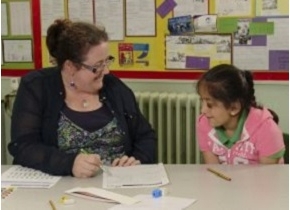
Request a full Catch Up® information brochure and details of our free information webinars
Find out more
The 0-25 SEND Code of Practice (2014) has brought some significant changes to the educational provision for pupils with SEN. At the heart of its philosophy is the integration of educational provision with health and social care provision, to provide more joined-up support for our most vulnerable members of society. There are also wide-ranging changes to the funding arrangements for pupils with SEN in school.
What else is new?
Liaison
Under the requirements of the Code of Practice, the class/subject teacher has overall responsibility for liaison between TA support and whole class goals and objectives.
The SENCo has responsibility for the content and manner of the support needed. This puts much greater emphasis on liaison between interventions and the mainstream classroom.
How does Catch Up help with liaison between intervention and the classroom?
1. Target sheet/learner profile
The Literacy targets sheet and Numeracy learner profile (initially completed after the first round of Catch Up Literacy or Numeracy assessments) provide a clear summary of the next steps of teaching and learning for the pupil. These targets should be discussed with the class/subject teacher to agree a coordinated approach to best assist the pupil in acquiring the skills.
NB Remember to update the class/subject teacher when new targets are set.
2. The individual session record sheet
Reinforcing work in the Linked writing/Linked recording boxes
In Catch Up Literacy, the focus word from each of the two sessions in the week could form part of the weekly spelling list for a Primary pupil. The focus word could be linked to words with the same pattern or phonemes to create a list of 8-10 words. For example, if the pupil has worked on adjacent consonants ‘st’ in a session, then all the words practised in ‘linked writing’ could become the pupil’s spelling list for the week.
In Catch Up Numeracy, the particular component/activity that has been worked on (eg, within ‘Fractions and Decimals’, relating number of tenths to correct decimal notation) should be shared with the class/subject teacher so that the pupil can further practise the skill in classwork.
The ‘Comments’ box
If the pupil has made a reflective comment on their own learning in the ‘Comments’ box, that creates an ideal opportunity for the class/subject teacher to foster a ‘Can Do’ mentality by saying, ‘Now you can …’ .
The ‘Follow up’ box
The ‘Follow up’ box on the individual session record sheet can be used as a quick method of communication between the supporting adult delivering the intervention and the class/subject teacher.
For example, the class/subject teacher could make use of comments such as:
Catch Up® is the working name of The Caxton Trust, a not-for-profit charity registered in England and Wales (1072425) and Scotland (SC047557) as well as a company limited by guarantee (03476510). Catch Up is a registered trademark.
The Catch Up® Web site use "cookies" to help you personalise your online experience. A cookie is a text file that is placed on your hard disk by a Web page server. Cookies cannot be used to run programs or deliver viruses to your computer. Cookies are uniquely assigned to you, and can only be read by a web server in the domain that issued the cookie to you.
Click on the different category headings below to find out more. You can change your default settings very easily. To turn cookies on, click the button to the right. To turn cookies off, click the buttons to the left. Please read our cookie policy to find out more.
Performance monitoring cookies: Google Analytics cookies (_ga,_gid) - these can last up to 2 years.
Strictly necessary cookies used by the site content management system: PHPSESSID (used to record your logged in session) and allow_cookies (used to record that the user has consented to cookies) - these are either temporary (session) cookies or expire after no more than 30 minutes and are used to provide functionality as you navigate around the site and allow you to access secure areas.